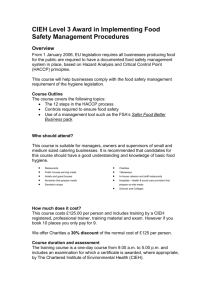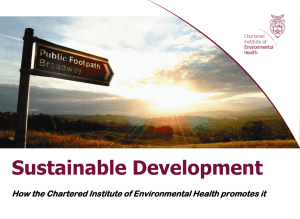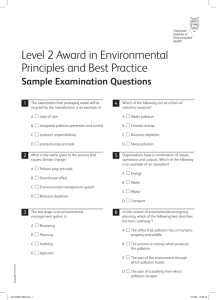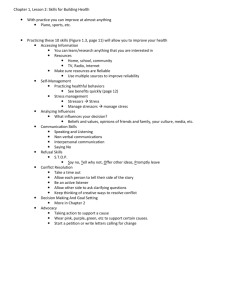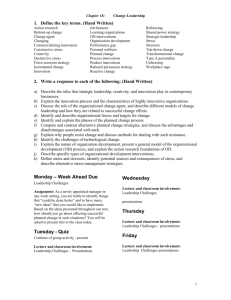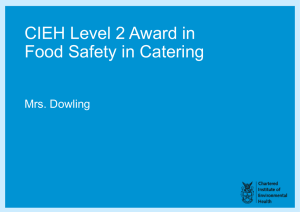element: interpersonal skills
advertisement
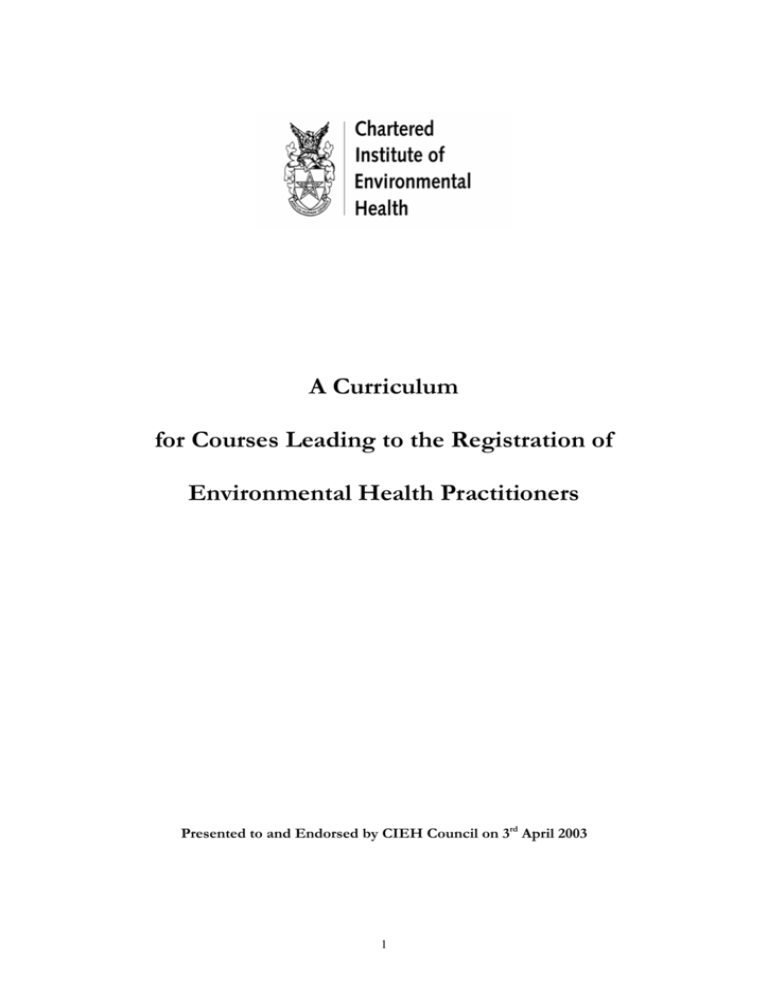
A Curriculum for Courses Leading to the Registration of Environmental Health Practitioners Presented to and Endorsed by CIEH Council on 3rd April 2003 1 CONTENTS 1.0 Aims and Objectives of the Curriculum ................................................................3 2.0 Design of the Curriculum and its Use in Course Development.........................4 3.0 Practical Considerations ...........................................................................................6 4.0 Cognitive Development in Subjects and Students................................................7 5.0 Minimum Entrance Requirements for Accredited Courses................................8 6.0 The Curriculum........................................................................................................10 6.1 The Physical Social and Human Worlds ......................................................10 6.2 Stressors and their Implications for Health.................................................11 6.3 The Interventions ............................................................................................11 6.4 Specified Minimum Intervention Areas .......................................................11 6.5 The Theoretical Basis for Operational Skills ...............................................13 6.6 Operational Skills.............................................................................................14 6.7 Core Competencies .........................................................................................15 6.8 Studies in Depth ..............................................................................................16 7.0 Work Based Learning..............................................................................................17 Appendix 1 CIEH/HDA Model of Environmental Health Services ...................19 Appendix 2 Bloom’s Taxonomy .................................................................................20 Appendix 2.1 Bloom’s Cognitive Progression .............................................................21 Appendix 3 CIEH Professional Progression Criteria ..............................................22 Appendix 3.1 CIEH Professional Progression Criteria ..............................................23 Appendix 4 Work Based Learning Matrix.................................................................24 2 CURRICULUM FOR COURSES LEADING TO THE REGISTRATION OF ENVIRONMENTAL HEALTH PRACTITONERS 1.0 AIM AND OBJECTIVES OF THE CURRICULUM 1.1 Aim To provide clear learning objectives to universities, students and organisations providing work-based learning within integrated programmes. The successful completion of these learning objectives will equip graduates, from an accredited University/College degree programme, with the necessary knowledge, experiences and key skills to commence the process that will not only lead to Registration with the Environmental Health Registration Board (EHRB) as an Environmental Health Practitioner (EHP) but will also lead to that person being considered to be competent by their employing organisation. 1.2 Overall Objectives On completion of an appropriate course of education (for which an appropriate degree will be awarded) and work-based learning an EHP will have: 1.2.1 1.2.2 developed an appropriate knowledge base concerning: y the physical / social / human worlds y the potential and actual impacts (in terms of public health) of a range of ‘stressors’ acting on those worlds developed an appropriate theoretical and operational skills base to enable the identification of: y the points at which interventions should take place to control or mitigate the adverse effects that arise from the impact of humans on the environment y the most appropriate intervention y the wider determinants of health and the measures necessary to reduce health inequalities and promote ‘well-being’. 3 2.0 DESIGN OF THE CURRICULUM AND ITS USE IN COURSE DEVELOPMENT 2.1 2002 saw the completion of a project jointly organised and funded by the Health Development Agency and the CIEH with the specific objective of supporting the environmental health profession in developing a strategic vision for its contribution to health development and well-being. Messrs. Burke, Gray, Paterson and Meyrick published the resultant project report entitled “Environmental Health 2012 – A Key Partner in Delivering the Public Health Agenda”, which was subsequently adopted by CIEH Council in September 2002. 2.2 The Curriculum structure is based on the schematic of environmental health services, adapted from the CIEH/Health Development Agency model, published in ‘Environmental Health 2012’. This model sees a number of ‘stressors’ acting on the environment as a whole which, individually and collectively, produce a series of impacts that are capable of being intervened against by Environmental Health Practitioners (see Appendix 1) 2.3 In essence, the Curriculum encompasses the study of the physical, social and human worlds and their interface with the environment; the study of the ‘stressors’, their public health impacts and the identification and implementation of appropriate ‘interventions’ for purpose of eliminating, controlling or mitigating the various public health impacts and for identifying opportunities to promote health and ‘well-being’. In addition, the Curriculum requires the study of policy, strategy and management (in respect of a series of prescribed minimum environmental health interventions), together with the in-depth study of significant interventions. 2.4 Consequently, and in overview, it is important to state that this Curriculum is designed specifically to produce specialists in environmental health through a generic degree programme with the additional requirement that students study significant interventions in-depth at final year for the purposes of: i) ii) iii) Facilitating the development of the holistic viewpoint; Considering the effects of the interventions (or absence of) on human health; and Understanding the essential need and benefits of working with other professionals, organisations or agencies in order to achieve the objectives of the intervention In other words, this in-depth study is designed to assist the student in making cognitive ‘connections’ in terms of the operational role of the EHP. 2.5 The major sections of The Curriculum are described as follows: 1. A statement of the broad areas to be studied in relation to the physical/ social and human worlds 2. A statement of the broad areas to be studied in relation to the physical, chemical, biological, social and psychosocial stressors and their associated health impacts 4 3. A statement of the broad knowledge and skills to be acquired and developed that will enable the EHP to develop, implement and monitor (or understand the processes associated with the development, implementation or monitoring of) the effectiveness of appropriate intervention strategies. 4. A statement of both the knowledge and understanding of the theoretical basis underpinning operational skills that will need to be acquired and developed by the student as part of the taught programme. 5. A statement of the appropriate levels of knowledge, understanding and experience, to be acquired and developed during the taught programme, which will enable the commencement of the process that will ultimately lead to competence in prescribed operational skills 6. A statement of the appropriate levels of knowledge, understanding and experience, to be acquired and developed during the taught programme, which will enable the commencement of the process that will ultimately lead to the attainment of ‘core competencies’. 7. A statement of the prescribed minimum interventions to be experienced by the student as part of the qualifying process. 8. A statement of requirements in respect of the studying of significant interventions in-depth. 2.6 Whilst not forming part of the programme to be taught by accredited Universities or Colleges, this document also contains a statement laying out the principles underpinning ‘work-based learning’ which is an important part of the whole curriculum for programmes of study leading to the qualification of EHPs. 5 3.0 PRACTICAL CONSIDERATIONS 3.1 The CIEH, in developing this Curriculum, is not intending to prescribe the structure of courses that subsequently receive its accreditation; however, the CIEH believes that the holistic, strategic approach to environmental health is extremely important. Universities are expected to structure their programmes to ensure that the holistic view and the strategic approach to environmental health are taught at appropriate points within the programme i.e. when the student already possesses the necessary knowledge and skills, to appreciate and understand the application of these concepts to environmental health practice. 3.3 The Curriculum consists of a number of broad subject areas - each commences with a statement regarding the required level of attainment supplemented by a list of learning outcomes. The CIEH does not intend that these subject areas should form the basis of individual teaching modules. The form and structure of the course is a matter for individual universities to decide, depending on their individual circumstances and programme goals. However, it is essential that universities ensure that students have the opportunity to achieve all of the learning outcomes during the course of study. 3.4 Similarly it is not intended by the CIEH that the order of teaching should necessarily follow the order of the Curriculum. Universities should ensure that the teaching of the curriculum follows a logical sequence taking into account the subject matter and the level of understanding required. 3.5 The University is encouraged to make the best use of, and develop synergies with, other programmes of study, which, whilst being to the benefit of all will add particular strength to the environmental health programme. 3.6 Each learning outcome will need to be taught at an appropriate level. This may be at level 1, 2, 3 or M. In some cases achievement of the learning outcome may be staged, beginning with the acquisition of lower cognitive levels but concluding with the specified appropriate level. The following section on “Cognitive Development in Subject Areas” will give an indication of the level and depth of study required in order to achieve the learning outcome. 3.7 In producing the Curriculum, the CIEH cannot anticipate developments and innovations within the field of Environmental Health. In view of this, universities must ensure that their programme is continuously updated to ensure the topicality of the material used. 6 4.0 COGNITIVE PROGRESSION IN SUBJECTS AND COGNITIVE DEVELOPMENT IN STUDENTS 4.1 It is expected that all accredited courses will be able to demonstrate cognitive progression in their taught subjects and cognitive development in their students, from first year through to final year. The CIEH advises that this development should be broadly in line with the principles set out in both Bloom’s Taxonomy (attached as Appendices 2 and 2.1) and the charts detailing the expected progression of professional skills from Level 1 to Level M (attached as Appendices 3 and 3.1). 4.2 By way of clarification of matters raised in 4.1, then it is to be expected that in the initial stages of a course of study leading to the award of a BSc the student will develop ‘knowledge’ and ‘understanding’. As the course develops this will lead to the development of skills relating to ‘application’ and ‘analysis’ and, finally, to the ability to ‘synthesise’ and ‘evaluate’ or ‘critically evaluate’. For MSc programmes, whilst there will be similar general cognitive development, there will, of necessity, be a greater concentration in the highest level skill of ‘critical evaluation’. 4.2 More specifically, the Chartered Institute expects that a significant proportion of the time will be spent on the study of: • Stressors and their public health impacts • Intervention points and strategies AND will concentrate on higher level cognitive skills i.e. • • Synthesis • Evaluation • Critical evaluation – This is viewed as being crucial for MSc courses Such a concentration not only reflects the operational level of the EHP but also of Technical Support staff. The latter, in carrying out technical inspections, are expected to exercise cognitive skills in the lower two-thirds of Bloom’s categories 7 5.0 MINIMUM ENTRANCE REQUIREMENTS FOR ACCREDITED COURSES Whilst it is the responsibility of a University or College, seeking accreditation from the CIEH for a course of study, to outline and justify their entry criteria; the following may be used as a guide: 5.1 UNDERGRADUATE PROGRAMMES ENTRANTS SHOULD NORMALLY HAVE: 5.1.1 Passes in the following subjects of the GCSE at grade ‘C’ or better: English Language Biology Physics Mathematics Chemistry Note: a ‘double pass’ in Integrated or Combined Sciences is generally accepted as an alternative to Biology, Chemistry and Physics. AND At least two passes at GCE Advanced Level (A2) including one science subject with the achievement of a minimum of 160 UCAS Tariff Points; alternatively, where a science subject is not passed at A2 level, then the achievement of a minimum of 200 UCAS Tariff Points, from at least two passes at A2 level, is required. Notes: (i) (ii) (iii) UCAS Tariff Points cannot be counted from AS or A2 examinations in General Studies and ‘non academic’ subjects such as Photography and Physical Education. Overlapping subjects should not be accepted Science subjects are generally agreed to include: Biology, Chemistry, Physics, Environmental Science, Nutrition and Food Science and Mathematics. Other subjects such as Geography and Sports Science may be acceptable, at the discretion of the CIEH, subject to evidence being provided that there is substantial relevant scientific content within the particular curriculum. OR 5.1.2 A BTEC National Certificate or Diploma in an appropriate science or technology with at least 5.0 Merit passes in subjects at N level or above. OR 5.1.3 A BTEC Higher National Certificate or Diploma in an appropriate science or technology with at least 6.0 Merit passes in subjects at H level or above. OR 8 5.1.4 The attainment of 24 credits via a Science Access Course accredited by the Open College Network. Sixteen (16) of the credits should be at level 3. The core skills module should have been successfully completed. OR 5.1.5 A degree of a United Kingdom university, or the Council for National Academic Awards (CNAA). OR 5.1.6 Qualifications and experience considered to be equivalent to the above after due consideration by the admitting university under policies and procedures which have been approved previously by the CIEH during the accreditation procedure or by the Qualifications Board. Any student admitted under this section should be declared in the university’s annual report to the CIEH. OR 5.1.7 Exceptionally, entrants not qualified under the above may be admitted when the candidate can demonstrate the potential to achieve the aims and outcomes of the Curriculum and the university has adequate resources and commitment to support the learning needs of that particular student. Any student admitted under this section should be declared in the university’s annual report to the CIEH. 5.2 POSTGRADUATE PROGRAMMES ENTRANTS SHOULD HAVE 5.2.1 A lower second class (2:2) Honours degree (or better) in a pure or applied science (or combination) of a UK university or the CNAA. OR 5.2.2 Qualifications and experience considered to be equivalent to the above after due consideration by the admitting university under policies and procedures which have been approved previously by the CIEH during the accreditation procedure or by the Qualifications Board. Any student admitted under this section should be declared in the university’s annual report to the CIEH. OR 5.2.3 Exceptionally, entrants not qualified under the above may be admitted by the University where the candidate can demonstrate the potential to achieve the aims and outcomes of the Curriculum and the university has adequate resources and commitment to support the learning needs of that particular student. Any student admitted under this section should be declared in the university’s annual report to the CIEH. 9 6.0 THE CURRICULUM 6.1 THE PHYSICAL, SOCIAL AND HUMAN WORLDS 6.1.1 At the completion of the taught programme, an EHP will be able to demonstrate ‘knowledge’ and ‘understanding’ of the following in preparedness for ‘application’: y The Biosphere and its Processes y The principles of ecology and their relationship to aspects of environmental health y The principles of sociology and their importance to aspects of environmental health y Psychological aspects of group function and its application in the practice of environmental health. y The principles of micro and macro economics and their importance in society. y The principles involved in the good governance of communities y The concept of ‘health’, ill-health and disability, ‘well-being’ and ‘quality of life’; the cost / benefit analysis of health; the principles of ‘personal choice / social responsibility’ and ‘citizenship y The concept of disease and ill-health arising from stressors acting on the ‘sphere’, together with the roles and responsibilities of health practitioners y The concept of risk and principles surrounding its assessment. y The value and practice of ‘good’ communications to environmental health y The principles underpinning research and the importance of evidence to the good practice of environmental health. 10 6.2 Stressors and Their Implications for Health 6.2.1 At the completion of the taught programme, an EHP will be able to demonstrate ‘knowledge’ and ‘understanding’, as well as a capacity to apply the skills of ‘synthesis’ and ‘evaluation’ in respect of the following: y The range of biological, chemical, physical, social and psychosocial stressors that may act upon the physical, social and human worlds y The points of possible impact of the stressors on the physical, social and human worlds y The mechanism of impact of the stressors on the physical, social and human worlds y The potential and actual public health implications that arise from the impact of stressors on the physical, social and human worlds 6.3 The Interventions 6.3.1 At the completion of the taught programme an EHP will be able to : y Identify the points at which EHPs may intervene to prevent, control or mitigate the impact of stressors on the physical, social and human worlds y Identify partner organisations, fellow professionals and others with whom appropriate intervention strategies might need to be formulated y Determine the most appropriate intervention to exercise, having regard to the factors, be they political, financial and technological that are likely to influence the decision making process y Implement appropriate intervention strategies y Monitor and review the effectiveness of the intervention strategy; altering or adapting it, where necessary, according to the actual or predicted outcome 6.4 Specified Minimum Intervention Areas 6.4.1 At the completion of the taught programme, all EHPs, in order to develop a wider view of the health implications associated with food safety, health and safety, environmental protection, housing, ‘public health’ issues and sustainability, MUST have developed the full range of cognitive skills from the study of ‘interventions’ associated with: 11 6.4.2 6.4.3 6.4.4 Food Safety: y The means of preventing the contamination or spoilage of food y The processes associated with the preservation of food y y Hazard Analysis Critical Control Point (HACCP) systems Inspection and identification of food and the making of judgments regarding fitness and wholesomeness y Auditing of food premises y The legislative and practical considerations associated with food standards y The investigation of an outbreak of food-related illness Health and Safety y The role of safety committees and employees representatives in preventative interventions and the monitoring of health and safety in the workplace y The identification of strategies for the management of occupational health or occupational hygiene hazards y The auditing of high risk processes and the identification of appropriate controls y The interface of workplace health and safety with the public y The determination of the ‘effectiveness’ of an employer’s safety management system and their ability to self-regulate y The investigation of a work-related illness y The investigation of a workplace accident, incident, dangerous occurrence or ‘near miss’. Housing y The application of housing law to the maintenance and improvement of the private sector housing stock y The application of housing law to the determination of the suitability for occupation of houses y The exploration of means of protecting the health, safety and welfare of those in multi-occupied housing y The delivery of strategies regarding: 12 ¾ Area renewal ¾ Financial support for private sector housing 6.4.5 6.4.6 Environmental Protection y The process of issuing permits in respect of “A2” installations under the Pollution Prevention and Control Act 1999. y The assessment of a noise emitted from an industrial premises y The determination of a contaminated land site y The safety of a private water supply y The exercise of various powers for dealing with illegally dumped solid waste y The principles of sustainable development y The legal principles behind the concept of statutory nuisance y The role of EHPs in the implementation of emergency plans. Public Health y The surveillance and control of clinical diseases of public health significance y Health protection measures and methods y Inequalities in health development y Improving health and ‘well-being’ y Sustainable development and health 6.5 The Theoretical Basis for Operational Skills 6.5.1 At the completion of the taught programme, an EHP will be able to demonstrate ‘knowledge’ and ‘understanding’ of the theory and practice of: y The cognitive and educational processes at work in: o Acquiring knowledge, o Raising awareness, and o Modifying behaviour y Organisational management in an environmental health context. 13 y The performance of inspections and audits y Good communications within and between organisations, including how organisations as a whole and teams within organisations, work best together y Good presentational skills y The development and operation of a range of compliance strategies y Professional ethics in an environmental health context 6.6 Operational Skills 6.6.1 At the completion of the taught programme, an EHP will have attained appropriate levels of knowledge, understanding and experience to enable the commencement of the process that will ultimately lead to competence in the following operational skills : Assess – Be aware of, and able to practice, those analytical skills that form the basis of professional judgement Consult – Be aware of, and able to practice, the full range of techniques for giving and receiving information Advise – Be able to communicate technically correct information for the purpose of informing colleagues, clients and others of the most appropriate course of action to be taken in a wide range of circumstances Enforce - Be aware of and be able to use the full range of mechanisms available for securing compliance with legislative provisions, statutory requirements and standards, commensurate with the perceived level of risk Train / Educate – Be aware of and able to use a range of practical skills associated with education in an environmental health context for the purpose of: y Acquiring knowledge, y Raising awareness, and y Modifying behaviour Advocate – Be able to support, promote and campaign on behalf of a range of issues. Evaluate – Be able to consider all aspects of an environmental health issue and be able to apportion values which can be supported and defended Research – Be able to: y Discover, identify and use appropriate information sources 14 y Critically assess options in day to day practice y Undertake a research exercise from planning to report stages 6.7 Core Competencies 6.7.1 At the completion of the taught programme, an EHP will have attained appropriate levels of knowledge, understanding and experience to enable the commencement of the process that will ultimately lead to the achievement of competence in their ability to: y Plan and execute inspections, investigations and audits y Plan and execute statistically reliable sampling programmes y Organise and interpret data obtained from audits and sampling programmes and compare / evaluate it against prescribed standards and guidelines y Determine and articulate the nature of a hazard and quantify the level of risk associated with that hazard y Choose and implement the appropriate legislative requirements (based on an analysis of the costs and benefits of taking action or not) to eliminate, reduce or mitigate the level of risk associated with a hazard y Obtain admissible evidence, serve legal notices, prepare legal summaries and witness statements y Design, implement and evaluate a research protocol for the purpose of gathering evidence to substantiate a course of action y Determine and articulate the opportunities and means to eliminate, reduce or mitigate the level of risk associated with a hazard. y Taking account of the level of risk and other commercial, social, economic and public health considerations, identify and implement the most appropriate course of action to achieve compliance with applicable legislation and / or codes of practice and guidelines y Identify and articulate the rights and responsibilities of individuals and organisations whose acts or omissions might impact on public health y Identify, link, co-operate and work with other professionals, organisations and agencies for the protection, enhancement and promotion of public health y Formulate, articulate and implement policies and strategies for the protection, enhancement and promotion of public health 15 y Identify and practice the skills necessary to facilitate personal, financial and organisational management y Communicate appropriately with a range of people and organisations using suitable language and means of delivery. 6.8 Studies ‘In-Depth’ 6.8.1 All student Environmental Health Practitioners must, as part of their qualification course, spend time studying significant interventions ‘in depth’. 6.8.2 ‘In depth’ means the study of significant interventions at ‘Level 3’ or ‘Level M’ to an extent equivalent to not less than 40 credit points or one-third of the final year of a BSc (Hons) programme. 6.8.3 The ‘in-depth’ studies should: y Facilitate the development of the holistic viewpoint; y Extend beyond the intervention area which is the main focus of the potential impact; y Consider the actual or potential effects of the interventions (or absence of) on human health; y Understand the essential need and benefits of working with other professionals, organisations or agencies in order to achieve the objectives of the intervention 6.8.4 One of the purposes of the ‘in-depth’ study is to facilitate the development of an holistic view of the subject and its inter-relationships with other aspects of environmental health 6.8.5 It is the responsibility of Universities / Colleges, seeking accreditation from CIEH, to identify both the scope and depth of the subjects to be studied ‘indepth’ by students. 16 7.0 WORK BASED LEARNING NB Work-based learning is an essential part of the overall Curriculum to be followed by student EHPs seeking the Certificate of Registration of the Environmental Health Registration Board (EHRB); however, workbased learning is not an essential requirement of a degree programme that seeks accreditation by the CIEH 7.1 ‘Work-based learning’ takes place within a work experience setting and involves the acquisition and/or development of key operational skills and the experiencing of core competencies across the range of environmental health subject areas. 7.2 The student will need to produce a portfolio of evidence which will demonstrate that they had achieved sufficient experience of each core competence, in a sufficiently broad range of interventions, to enable the student to apply their knowledge and skill in any aspect of environmental health work in the future. Appendix 4 shows how such ‘experience’ might be logged. 7.3 Work-based learning will be directed through a ‘workbook’ which will provide guidance for the student on the range of environmental health interventions needed to be experienced, and the key skills to be demonstrated, through their work-based learning. 7.4 For each core competence, evidence, in a minimum number of intervention areas, will need to be provided by the student in order to satisfy the CIEH of achieving a specified level of experience. 7.5 The full range of intervention areas will need to have been covered during the work-based learning period, with a minimum number of different types, within each intervention area, contributing to the overall attainment of the required experience. 7.6 A student must access sufficient examples of each specified intervention, in appropriate contexts, to demonstrate the achievement of the required experience. 7.7 Work-based learning may be undertaken in any work environment (including the voluntary sector), with no minimum timescale and no minimum period required within a local authority. 7.7.1 All students taking part in work-based learning must meet the objectives set out in the work-based learning ‘workbook’ 7.7.2 It is envisaged that work based learning is likely to take at least 9 to 12 months to complete successfully – if undertaken through a highly organised and strictly managed programme. Where the student is already working in a specific area of environmental health (perhaps as a Technical Officer), work-based learning is likely to take around 2 years to complete successfully. 7.8 The achievement of specific experiences associated with taking admissible evidence, serving legal notices and preparing prosecution briefs remains a key objective of work-based learning. 17 7.8.1 It is envisaged that the student will need to experience some interventions within a local authority or government department / agency which hold an enforcement remit in order to demonstrate the necessary work-based experience associated with some interventions and some core competencies. 7.9 In order to provide a focus for the work-based learning and to ensure the appropriate depth of experience, the student, as part of the requirements of the work-based learning workbook, must complete a significant integrating case study. 7.9 The case study must: y Facilitate the development of the holistic viewpoint; y Relate to more than one ‘intervention area’, and y Involve working with other organisations or agencies in order to achieve the objective of the intervention. 18 Appendix 1 The ‘2012 Vision’ Model of Environmental Health Recreat ion al Env iron ment People g in ld ui B Social Stressors Psychos ocial Stressors 19 by assessing, correcting and preventing impact of stressors Physical Stressors Contributions of Environmental Health Practitioners: Wo r k Env iron ment Chemical Stressors Air Te ch no log Water y L iv ing Env ir on ment La nd OPERATIONAL SKILLS Biologic al Stressors Food Ho me Env iron ment THE STRESSORS als im An Sphere of environmental health KNOWLEDGE B ASE Inspect / Audit Assesses Consults Ad vises Enforces Trains/Educates Ad vocates Evaluates Researches Appendix 2 – Bloom’s Taxonomy Benjamin Bloom created this taxonomy for categorising the level of abstraction of questions that commonly occur in educational settings. The taxonomy provides a useful structure in which to categorise cognitive development. L3 Accredited courses should show cognitive progression across all domains but should concentrate on higher level skills L2 L1 L1, L2 and L3 indicate approximate cognitive development expected by CIEH in relation to academic level of BSc programmes 20 Appendix 2.1 - Bloom’s Cognitive Progression Competence Skills Demonstrated Knowledge observation and recall of information knowledge of dates, events, places knowledge of major ideas mastery of subject matter Question Cues: arrange, define, duplicate, label, list, memorize, name, order, recognize, relate, recall, repeat, reproduce state. Understanding understanding information grasp meaning translate knowledge into new context interpret facts, compare, contrast order, group, infer causes predict consequences Question Cues: classify, describe, discuss, explain, express, identify, indicate, locate, recognize, report, restate, review, select, translate, Application use information use methods, concepts, theories in new situations solve problems using required skills or knowledge Questions Cues: apply, choose, demonstrate, dramatize, employ, illustrate, interpret, operate, practice, schedule, sketch, solve, use, write. Analysis seeing patterns organization of parts recognition of hidden meanings identification of components Question Cues: analyze, appraise, calculate, categorize, compare, contrast, criticize, differentiate, discriminate, distinguish, examine, experiment, question, test. Synthesis use old ideas to create new ones generalize from given facts relate knowledge from several areas predict, draw conclusions Question Cues: arrange, assemble, collect, compose, construct, create, design, develop, formulate, manage, organize, plan, prepare, propose, set up, write. Evaluation compare and discriminate between ideas assess value of theories, presentations make choices based on reasoned argument verify value of evidence recognize subjectivity Question Cues appraise, argue, assess, attach, choose compare, defend estimate, judge, predict, rate, core, select, support, value, evaluate. 21 Appendix 3 CIEH Professional Progression Criteria Domains Level 1 Level 2 Level 3 Level M Technical Skills Choose appropriate ‘tools’ and use them for the accomplishment of simple tasks Choose and develop the applicatio n of appropriate ‘tools’ to the accomplishment of more complex set tasks. Application of a range of complex ‘tools’ to novel situations in achieving innovative solutions. Application and critical evaluation of the effectiveness of a range of complex ‘tools’ to novel situations in achieving innovative solutions Organisation and Planning Organisatio n of self, planning and organisation of tasks under close supervision, ability to organise and plan own studying patterns. Organisation of self, planning and organisation of tasks with increasing levels of independence and involving negotiation of outcomes and process. Ability to work autonomously over significant extended academic tasks and able to accept accountability for the process and outcomes. Ability to work autonomously over significant extended academic tasks; to offer both critical evaluatio n and acco untability for the process and outcomes Communication Ability to communicate in a clear and concise way, both written and orally, in relatively informal and limited length pieces of work, using appropriate technology. Ability to communicate in a clear and co ncise way, both written and orally, in more formal academic styles and in extended pieces of work. Ability to communicate in a clear and concise way, both written and orally, in formal styles in relation to major pieces of academic work Ability to communicate in a clear and co ncise way, both written and orally, in formal and informal styles in relation to all work. Such clarity must extend to the communication of evaluative work. Group / Inter-personal Ability to operate effectively and constructively in groups, albeit largely in an intuitive way. Ability to begin to operate effectively in groups in professional and vocational settings with understanding of roles, leadership and the dynamics of groups. Ability to interact with gro ups and individuals from vocational and professional settings, with a broad and self critical awareness. Ability to interact with and lead groups and individuals from all settings, with a broad and self critical awareness. Data Collection and Interpretation Collection and organisation of data mostly from common and recommended secondary sources. Collectio n and organisation of data independently from a wide range of secondary sources, the increasing acquisition of simple primary data collection techniques. Extensio n of knowledge of and capability with primary data collection methods and growing awareness of the choice and application of suitable methods. Ability to develop primary data collectio n models with an ability to evaluate the likely effectives of appropriate choices 22 Appendix 3.1 CIEH Professional Progression Criteria Domains Level 1 Level 2 Level 3 Theory and Principles Kno wledge and understanding of key theories and principles altho ugh still as discrete parts of a necessarily fragmented framework. Kno wledge and understanding of key theories and principles but with a clearer understanding of their inter-relatio nships and discriminatio n of their relevance in different co ntexts. Ability to combine kno wledge, theories and principles in no vel ways in the analysis and solutio n of complex substantial problems. Ability to combine kno wledge, theories and principles in no vel ways in the analysis, synthesis, critical evaluatio n and so lutio n of all types of problems. Analysis and Reflection Ability to analyse simple situatio ns and problems for the relevant factors and main inherent issues. Ability to analyse more complex situatio ns and problems for relevant factors/issues and demo nstrate/justify the validity of analytical process. Ability to analyse complex situatio ns and problems from a range of different viewpoints / theoretical standpoints and with some objectivity. Ability to analyse, synthesise and offer critical evaluatio n of complex situatio ns and problems from a range of different viewpoints / theoretical standpoints and with some objectivity. Application and Reflection Ability to apply learned theory and principles to straightforward and relatively unambiguo us situatio ns and problems. Ability to apply appropriate clusters of theories and principles to more complex and relatively ambiguo us situatio ns and problems and begin to reflect o n the process. Ability to apply learned theory and principles in the identification of a range of valid solutio ns to complex problems and begin to reflect o n the appropriateness of theory, practice and o utcomes. Ability to apply learned theory and principles in the identificatio n of a range of valid solutio ns to complex problems and to analyse, synthesise and evaluate the appropriateness of theory, practice and o utcomes. Synthesis and Evaluation Begin to organise, synthesise and evaluate structures for/and relatio nships between the kno wledge and principles of the subject. Ability to identify a range of valid alternative so lutions and to begin to discriminate and evaluate amo ngst these solutio ns in a reaso ned way. Ability to synthesise theory and professional / vocatio nal practice and to evaluate theory, process, solutio ns and o utcomes. Ability to analyse and synthesise theory and professional / vocatio nal practice and to critically evaluate theory, process, so lutions and outcomes. Creativity Can identify and appreciate novel/original aspects of and perspectives o n the subject. Ability to begin to express perso nal views/perspectives in relatio n to kno wledge, issues and solutio ns within the subject, that are fo unded in/stemming from authoritative so urces. Begin to identify new perspectives in and modifications to existing kno wledge, structures, new areas for investigatio n, new problems for solutio n, transfer of kno wledge/ solutio ns into new contexts. Ability to identify new perspectives in and modificatio ns to existing kno wledge and structures. To identify new areas for investigatio n, new problems for solutio n and the ability to learn from the o utcomes; to further modify as necessary and to transfer kno wledge / solutio ns into new co ntexts. 23 Level M Food Inspection and Fitness Auditing of Food Premises AB A B CE B A B C B C D AE D E A AD D B CE C A BE DE A B BC A A B AC E B D C A D D A D B A D C C A E C B DF C E BD EF C B E C B Determining the 'Effectiveness' of Safety Management Systems A A A E B BC D BCD BC AD AE C AC D C CD D B E C D A E D 24 The Suitability for Occupation of Houses AB Manitenance and Improvement of Private Sector Housing Accident Investigation AB Investigating Work-Related Illness The Interface of Workplace H&S with the Public CD Auditing of high risk processes Managing Occ Health and Occ Hygiene Hazards Preventaive Interventions in H&S Food Poisoning Investigation A Food Standards HACCP Food Preservation Inspections, Investigation & Audits Sampling Regimes Analyse & Interpret Data Hazards & Associated Risks Interpret Legislative Requirements Legal Processes Undertake Appropriate Research Identify Solutions to Problems Determine the Most Appropriate Course of Action to Achieve Compliance Rights & Responsibilities of Individuals Work with Others Develop Policy & Strategies Management Skills Communication Skills Contamination of Food A A C B B BC CD A AD D B A A AB B DE B A BC D AC C A DF AC BE A BC A D D A B C D A C B C CD D B A C BD D B C B E D C C A BC B A C C BC AB BC C Sustainable Community Developmentand Health Improving Health and 'Well-Being' Inequalities in Health Development and Health Health Protection Measures and Methods Clinical Diseases of Public Health Significance Emergency Planning Prejudicial to Health & Nuisance Illegal Dumping of Solid Waste Safety of a Private Water Supply B A Determination of a Contaminated Land Site Assessment of Noise from Industrial Premises Issuing Permits for A2 Installations Financial Support for Private Sector Housing Area Renewal B Multi-Occupancy Housing Appendix 4 A AD A A C B C D AC C BC D AC BD AD B CD C C B This type of grid could be used by a student to show where each of, say, 4 examples of each prescribed intervention had been experienced to demonstrate achievement of the core competencies. For each prescribed intervention area their examples are labelled A, B, C, D, E etc to show acquisition of the core competence. D B 25
